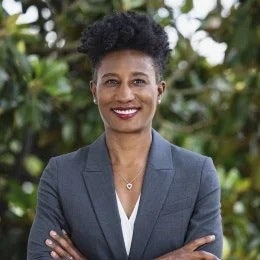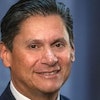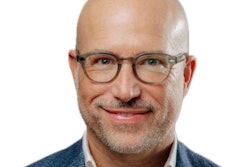Despite pledges from campus leaders to diversify all facets of their institutions, faculty have remained stubbornly white, according to a new report from the Education Trust, a non-profit that works to close opportunity and achievement gaps.
“It reflects something that we’ve long known,” said Dr. Kimberly A. Griffin, professor and dean of the College of Education at the University of Maryland. “That the student body is diversifying much faster than the faculty is.”
The report, based on 2020 data from 543 public four-year institutions, graded schools by comparing the percentage of minoritized students to the percentage of minoritized faculty. The more similar the percentages, the higher the grade. A school with a 10% Black student body that had a 9% Black faculty would have received an A. A school with a 10% Black student body but under 6% Black faculty would have received an F. The results, for many colleges, were not pretty.
57% of schools had failing grades for Black faculty diversity, and 79% had failing grades for Latinx diversity. Only 13% of colleges received the highest possible grade when it came to African Americans, and only 7% received top marks for Latinx diversity.
 Dr. Kimberly A. Griffin, professor and dean of the College of Education at the University of Maryland
Dr. Kimberly A. Griffin, professor and dean of the College of Education at the University of Maryland
The lack of diversity has far-reaching consequences. More diverse faculties have been linked to higher retention, persistence, and graduation rates for minoritized students, as well as an improved sense of belonging. And the benefits aren’t limited to those from under-represented backgrounds. White students taught by diverse faculty have shown better cross-cultural and critical thinking skills and have a stronger sense of empathy.
The report also examined new hiring decisions, with similarly dismal results: Black and Latinx faculty were disproportionately hired for non-tenure track positions. At 35 schools, all new Black faculty were hired for non-tenure track positions, and 50 schools did not hire any Black faculty at all. 48 institutions hired no Latinx faculty on the tenure track, and 76 hired no Latinx faculty at all.
When it came to who ultimately got tenure, there was also little equity to be found. The share of tenured Black and Latinx professors tended to be lower than the percentage of all tenured full-time faculty. Only 45% of institutions were able to achieve a top grade in tenure equity for Black scholars, and only 55% did for Latinx scholars.
It’s a problem with myriad causes, said Griffin.
“Black scholars [and] Latinx scholars experience challenges all along the journey to becoming professors,” she said. “There are roadblocks all along the way, whether [they] be microaggressions, bias, being left out of networks, [or] facing hiring, tenure and promotion processes that don't recognize the unique talents and gifts that they bring to the table.”
This multitude of barriers helps explain the report’s last main finding: that things have changed little over time. An analysis of data since 2005 shows that percentages of minoritized faculty haven’t increased much, even as student bodies have grown more diverse.
Part of the reason for this is because colleges have not worked to change their hiring practices, according to Dr. Marybeth Gasman, who holds the Samuel DeWitt Proctor endowed chair in education, is a distinguished professor, and the associate dean for research in the Graduate School of Education at Rutgers University.
“There’s a lot of talk about wanting a diverse faculty, but they’re not really doing the work to make that happen,” she said. “These procedures for hiring were designed a long time ago for mainly hiring white men. Most faculty members are hired from a small pool of Ph.D-producing institutions and a lot of [schools] aren’t going beyond that group. People tend to ask their friends for recommendations, and they have very narrow views of what quality means that are shaped by whiteness.”
Schools that showed the most growth tended to be ones that did not have any minoritized faculty at all in 2005.
“I think when the problem is that clear, institutions might mobilize more quickly,” said Griffin.
Many of the schools with the strongest improvements were minority serving institutions (MSIs). Five of the top 10 schools with highest percentage change of Black faculty were HBCUs or predominantly Black Institutions, and eight of the top 10 schools with highest change in Latinx faculty were Hispanic serving institutions. This made sense to Griffin.
“It seems consistent with what we know about these institutions, that MSIs will be thinking about, ‘how do we execute our mission to support students from underserved backgrounds?’” she said. “Having a diverse faculty is often part of that effort to support students.”
The report offered a plethora of recommendations for institutions and state and federal policymakers. Among them: schools should adopt specific goals for improving faculty diversity and set aside money to recruit and retain diverse faculty. States should rescind bans on affirmative action and prioritize the funding of schools that serve Black and Latino students. And federal leaders should use executive action to further DEI aims and provide technical assistance to schools that serve under-represented populations on grant eligibility and applications.
Griffin echoed these recommendations but cautioned that, even with increased demands for racial justice on college campuses post-George Floyd, there is a long road ahead.
“This is a problem that’s going to take many years to address,” she said. “It’s not just about whether we’re recruiting more Black [and] Latinx scholars into the institutions. It’s whether or not we’re able to retain them, whether or not they’re successfully navigating the tenure promotion process. Are they feeling welcomed and satisfied and recognized in their institutional context?”
Although the report’s results could be viewed as discouraging, Griffin sees them as an important first step. “It’s disappointing that this continues to be a problem,” she said. “But we can’t begin to address problems that we can’t really see.”
Jon Edelman can be reached at [email protected].















